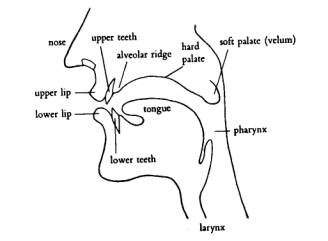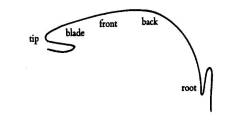To start off, let’s be clear of what phonology is and then look at the seven main articulators in our speech organs that are used in the production of speech.
There are seven main articulators:
Pharynx – a tube which begins just above the larynx. It is divided into two at its top, one part being the back of the mouth and the other being the beginning of the way through the nasal cavity. If you look in the mirror with your mouth open, you can see the back of the pharynx.
Velum / Soft Palate – often in speech, the velum is raised so that air cannot escape through the nose. It is also one of the articulators that can be touched by the tongue. When we make the sounds / k / and / g / the tongue is in contact with the lower side of the velum. Hence, these sounds are called velar consonants.
Hard Palate – it is often called ‘roof of the mouth’. You can feel its smooth curved surface with your tongue.
Alveolar Ridge – it is between the top front teeth and the hard palate. Its surface is covered with little ridges. You can feel its shape with your tongue. Sounds made with the tongue touching hers such as / t / and / d / are called alveolar.
Tongue – it is a very important articulator and can be moved into many different places and different shapes. The tongue is divided into different parts such as tip, blade, front, back and root. (see Figure 2.)
Teeth (upper and lower) – most speakers have teeth to the sides of their mouth. The back is almost to the soft palate. The tongue is in contact with the upper side for many speech sounds. Sounds made with the tongue touching the front teeth are called dental.
Lips – they are important in speech. The lips can be pressed together (to produce the sounds / p /, brought into contact with teeth (as in / f /, / v /), or rounded to produce the lip-shape for vowels like / u: /. Sounds in which lips are in contact with each other are called bilabial, while those with lip-to-teeth contact are called labiodental.
The seven articulators described above are the main ones but there are three other things to remember:
Larynx – it could also be described as an articulator; a very complex and an independent one. You can feel the vibration in your larynx (Adam’s apple) when you produce voiced sounds such as / z /.
Jaws – they are sometimes called articulators because the movement of the jaws (especially the lower one) helps a lot in speaking. However, the jaws are not articulators in the same way as the others because they themselves cannot make contact with other articulators.
Nose and nasal cavity – they are a very important part of our vocal apparatus of making sounds, particularly nasal consonants such as / m /, / n /. However, the nose and nasal cavity cannot really be described as articulators in the same way as the seven main articulators described above

